Impact of Intellectual Capital’s Value Addition to the Banks of Australia
VerifiedAdded on 2023/06/12
|7
|2142
|143
AI Summary
This literature review analyzes the impact of intellectual capital on the financial performance of banks in Australia. It covers common and different themes, managerial implications, and study limitations.
Contribute Materials
Your contribution can guide someone’s learning journey. Share your
documents today.
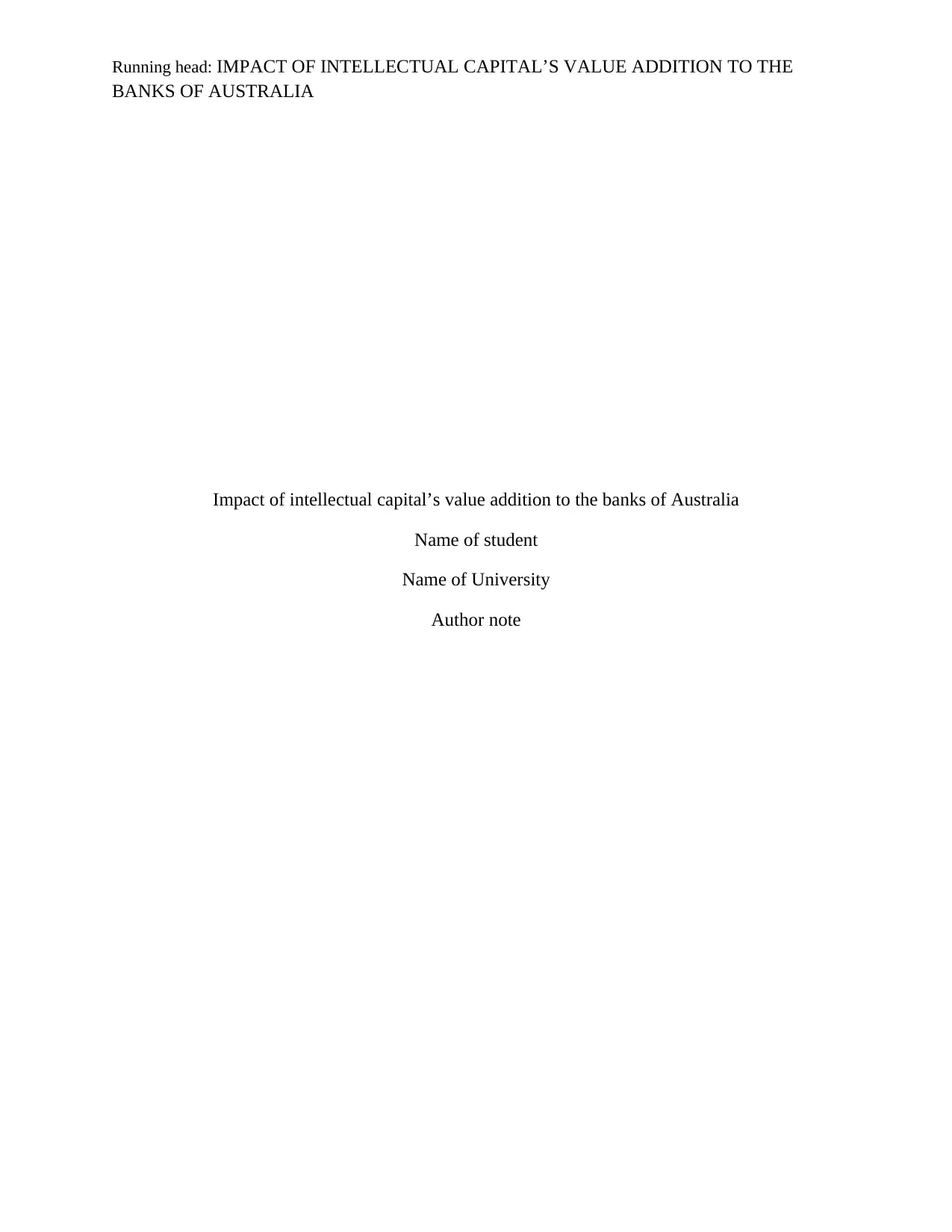
Running head: IMPACT OF INTELLECTUAL CAPITAL’S VALUE ADDITION TO THE
BANKS OF AUSTRALIA
Impact of intellectual capital’s value addition to the banks of Australia
Name of student
Name of University
Author note
BANKS OF AUSTRALIA
Impact of intellectual capital’s value addition to the banks of Australia
Name of student
Name of University
Author note
Secure Best Marks with AI Grader
Need help grading? Try our AI Grader for instant feedback on your assignments.
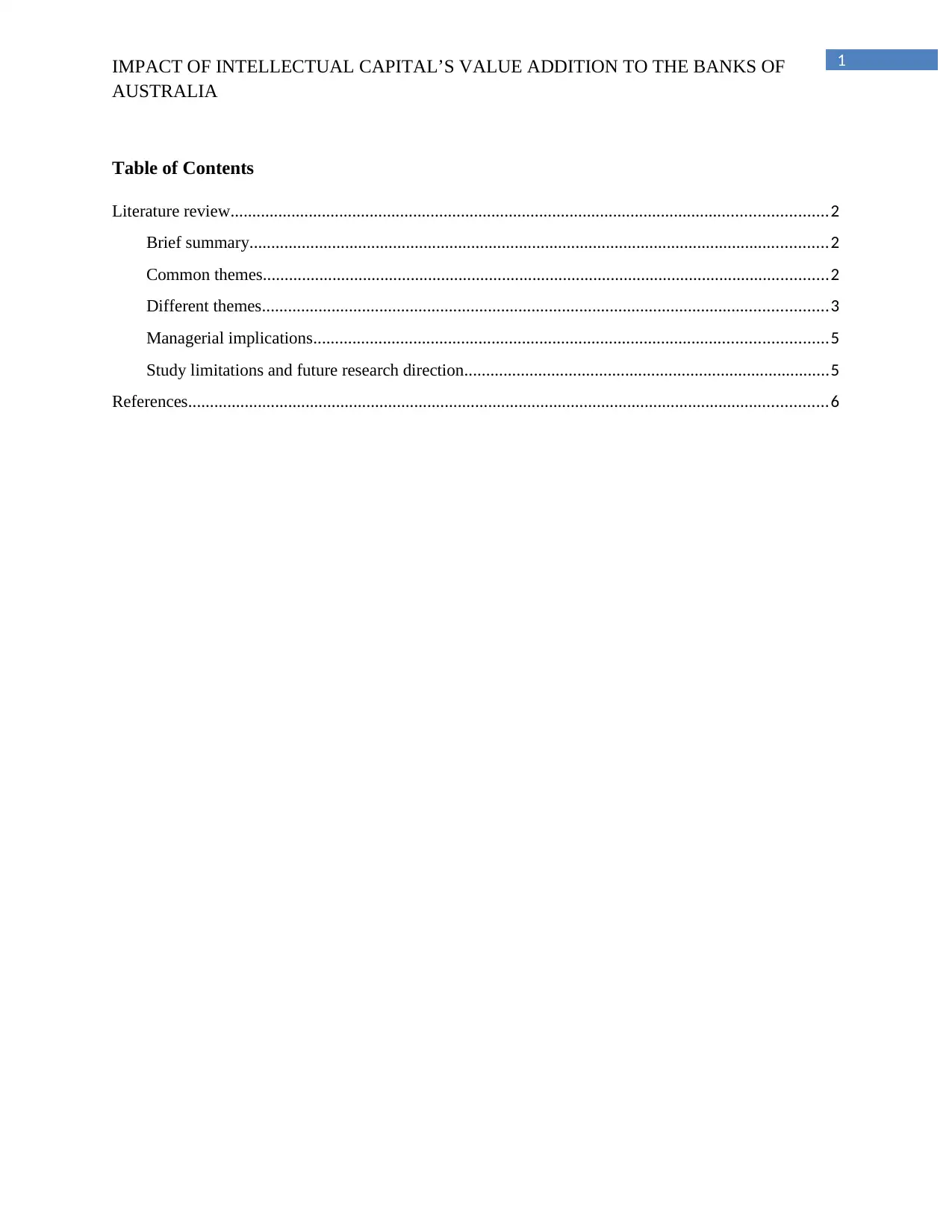
1IMPACT OF INTELLECTUAL CAPITAL’S VALUE ADDITION TO THE BANKS OF
AUSTRALIA
Table of Contents
Literature review.........................................................................................................................................2
Brief summary.....................................................................................................................................2
Common themes..................................................................................................................................2
Different themes..................................................................................................................................3
Managerial implications......................................................................................................................5
Study limitations and future research direction....................................................................................5
References...................................................................................................................................................6
AUSTRALIA
Table of Contents
Literature review.........................................................................................................................................2
Brief summary.....................................................................................................................................2
Common themes..................................................................................................................................2
Different themes..................................................................................................................................3
Managerial implications......................................................................................................................5
Study limitations and future research direction....................................................................................5
References...................................................................................................................................................6
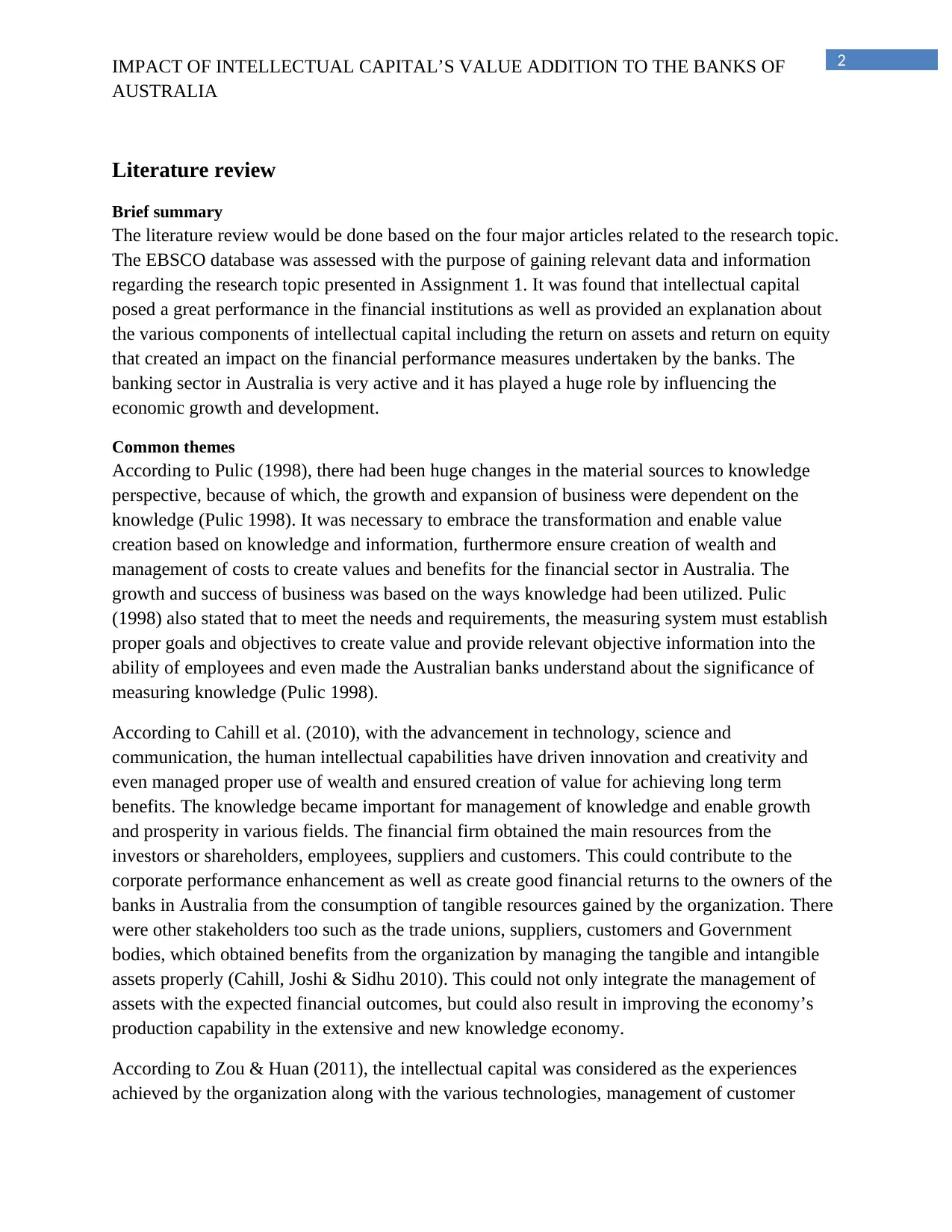
2IMPACT OF INTELLECTUAL CAPITAL’S VALUE ADDITION TO THE BANKS OF
AUSTRALIA
Literature review
Brief summary
The literature review would be done based on the four major articles related to the research topic.
The EBSCO database was assessed with the purpose of gaining relevant data and information
regarding the research topic presented in Assignment 1. It was found that intellectual capital
posed a great performance in the financial institutions as well as provided an explanation about
the various components of intellectual capital including the return on assets and return on equity
that created an impact on the financial performance measures undertaken by the banks. The
banking sector in Australia is very active and it has played a huge role by influencing the
economic growth and development.
Common themes
According to Pulic (1998), there had been huge changes in the material sources to knowledge
perspective, because of which, the growth and expansion of business were dependent on the
knowledge (Pulic 1998). It was necessary to embrace the transformation and enable value
creation based on knowledge and information, furthermore ensure creation of wealth and
management of costs to create values and benefits for the financial sector in Australia. The
growth and success of business was based on the ways knowledge had been utilized. Pulic
(1998) also stated that to meet the needs and requirements, the measuring system must establish
proper goals and objectives to create value and provide relevant objective information into the
ability of employees and even made the Australian banks understand about the significance of
measuring knowledge (Pulic 1998).
According to Cahill et al. (2010), with the advancement in technology, science and
communication, the human intellectual capabilities have driven innovation and creativity and
even managed proper use of wealth and ensured creation of value for achieving long term
benefits. The knowledge became important for management of knowledge and enable growth
and prosperity in various fields. The financial firm obtained the main resources from the
investors or shareholders, employees, suppliers and customers. This could contribute to the
corporate performance enhancement as well as create good financial returns to the owners of the
banks in Australia from the consumption of tangible resources gained by the organization. There
were other stakeholders too such as the trade unions, suppliers, customers and Government
bodies, which obtained benefits from the organization by managing the tangible and intangible
assets properly (Cahill, Joshi & Sidhu 2010). This could not only integrate the management of
assets with the expected financial outcomes, but could also result in improving the economy’s
production capability in the extensive and new knowledge economy.
According to Zou & Huan (2011), the intellectual capital was considered as the experiences
achieved by the organization along with the various technologies, management of customer
AUSTRALIA
Literature review
Brief summary
The literature review would be done based on the four major articles related to the research topic.
The EBSCO database was assessed with the purpose of gaining relevant data and information
regarding the research topic presented in Assignment 1. It was found that intellectual capital
posed a great performance in the financial institutions as well as provided an explanation about
the various components of intellectual capital including the return on assets and return on equity
that created an impact on the financial performance measures undertaken by the banks. The
banking sector in Australia is very active and it has played a huge role by influencing the
economic growth and development.
Common themes
According to Pulic (1998), there had been huge changes in the material sources to knowledge
perspective, because of which, the growth and expansion of business were dependent on the
knowledge (Pulic 1998). It was necessary to embrace the transformation and enable value
creation based on knowledge and information, furthermore ensure creation of wealth and
management of costs to create values and benefits for the financial sector in Australia. The
growth and success of business was based on the ways knowledge had been utilized. Pulic
(1998) also stated that to meet the needs and requirements, the measuring system must establish
proper goals and objectives to create value and provide relevant objective information into the
ability of employees and even made the Australian banks understand about the significance of
measuring knowledge (Pulic 1998).
According to Cahill et al. (2010), with the advancement in technology, science and
communication, the human intellectual capabilities have driven innovation and creativity and
even managed proper use of wealth and ensured creation of value for achieving long term
benefits. The knowledge became important for management of knowledge and enable growth
and prosperity in various fields. The financial firm obtained the main resources from the
investors or shareholders, employees, suppliers and customers. This could contribute to the
corporate performance enhancement as well as create good financial returns to the owners of the
banks in Australia from the consumption of tangible resources gained by the organization. There
were other stakeholders too such as the trade unions, suppliers, customers and Government
bodies, which obtained benefits from the organization by managing the tangible and intangible
assets properly (Cahill, Joshi & Sidhu 2010). This could not only integrate the management of
assets with the expected financial outcomes, but could also result in improving the economy’s
production capability in the extensive and new knowledge economy.
According to Zou & Huan (2011), the intellectual capital was considered as the experiences
achieved by the organization along with the various technologies, management of customer
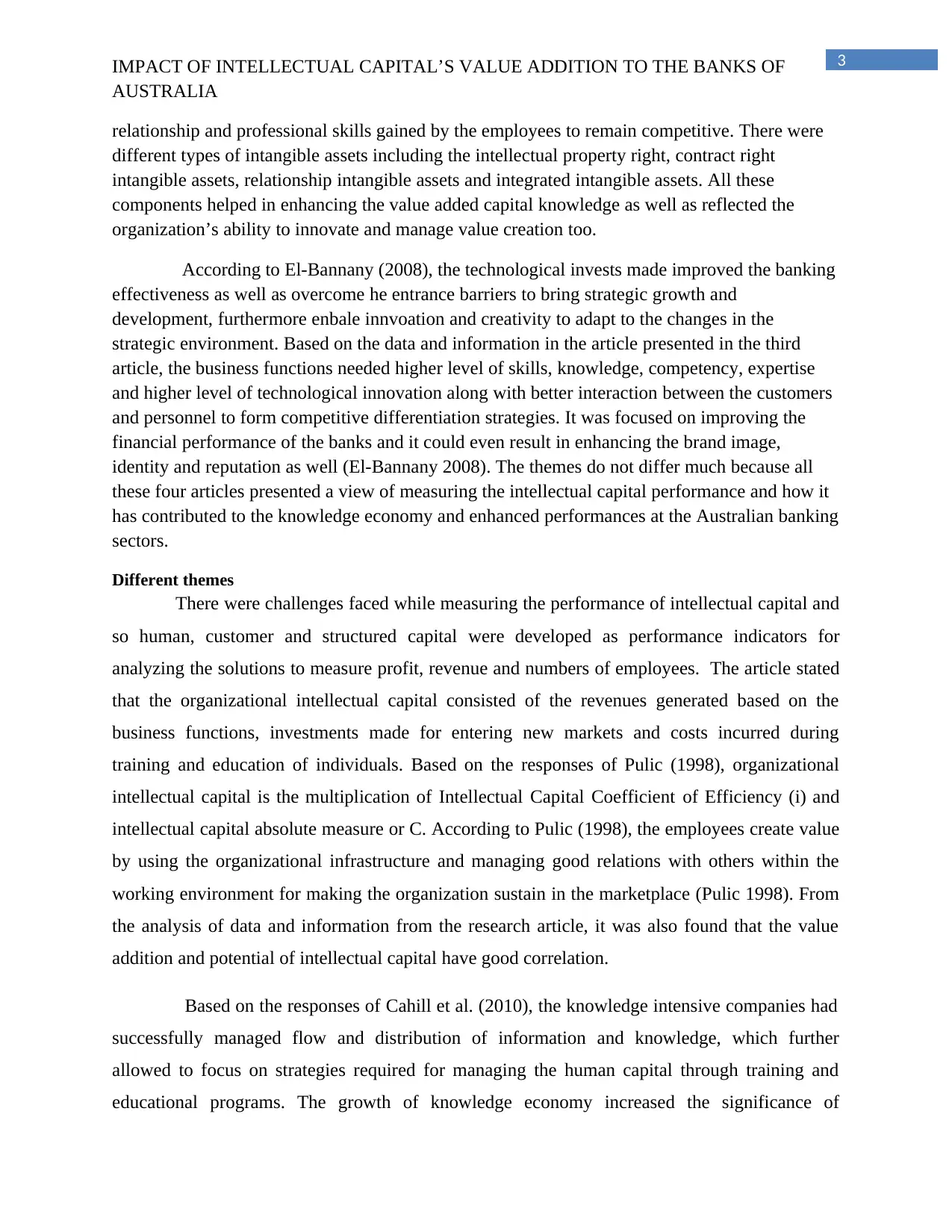
3IMPACT OF INTELLECTUAL CAPITAL’S VALUE ADDITION TO THE BANKS OF
AUSTRALIA
relationship and professional skills gained by the employees to remain competitive. There were
different types of intangible assets including the intellectual property right, contract right
intangible assets, relationship intangible assets and integrated intangible assets. All these
components helped in enhancing the value added capital knowledge as well as reflected the
organization’s ability to innovate and manage value creation too.
According to El-Bannany (2008), the technological invests made improved the banking
effectiveness as well as overcome he entrance barriers to bring strategic growth and
development, furthermore enbale innvoation and creativity to adapt to the changes in the
strategic environment. Based on the data and information in the article presented in the third
article, the business functions needed higher level of skills, knowledge, competency, expertise
and higher level of technological innovation along with better interaction between the customers
and personnel to form competitive differentiation strategies. It was focused on improving the
financial performance of the banks and it could even result in enhancing the brand image,
identity and reputation as well (El-Bannany 2008). The themes do not differ much because all
these four articles presented a view of measuring the intellectual capital performance and how it
has contributed to the knowledge economy and enhanced performances at the Australian banking
sectors.
Different themes
There were challenges faced while measuring the performance of intellectual capital and
so human, customer and structured capital were developed as performance indicators for
analyzing the solutions to measure profit, revenue and numbers of employees. The article stated
that the organizational intellectual capital consisted of the revenues generated based on the
business functions, investments made for entering new markets and costs incurred during
training and education of individuals. Based on the responses of Pulic (1998), organizational
intellectual capital is the multiplication of Intellectual Capital Coefficient of Efficiency (i) and
intellectual capital absolute measure or C. According to Pulic (1998), the employees create value
by using the organizational infrastructure and managing good relations with others within the
working environment for making the organization sustain in the marketplace (Pulic 1998). From
the analysis of data and information from the research article, it was also found that the value
addition and potential of intellectual capital have good correlation.
Based on the responses of Cahill et al. (2010), the knowledge intensive companies had
successfully managed flow and distribution of information and knowledge, which further
allowed to focus on strategies required for managing the human capital through training and
educational programs. The growth of knowledge economy increased the significance of
AUSTRALIA
relationship and professional skills gained by the employees to remain competitive. There were
different types of intangible assets including the intellectual property right, contract right
intangible assets, relationship intangible assets and integrated intangible assets. All these
components helped in enhancing the value added capital knowledge as well as reflected the
organization’s ability to innovate and manage value creation too.
According to El-Bannany (2008), the technological invests made improved the banking
effectiveness as well as overcome he entrance barriers to bring strategic growth and
development, furthermore enbale innvoation and creativity to adapt to the changes in the
strategic environment. Based on the data and information in the article presented in the third
article, the business functions needed higher level of skills, knowledge, competency, expertise
and higher level of technological innovation along with better interaction between the customers
and personnel to form competitive differentiation strategies. It was focused on improving the
financial performance of the banks and it could even result in enhancing the brand image,
identity and reputation as well (El-Bannany 2008). The themes do not differ much because all
these four articles presented a view of measuring the intellectual capital performance and how it
has contributed to the knowledge economy and enhanced performances at the Australian banking
sectors.
Different themes
There were challenges faced while measuring the performance of intellectual capital and
so human, customer and structured capital were developed as performance indicators for
analyzing the solutions to measure profit, revenue and numbers of employees. The article stated
that the organizational intellectual capital consisted of the revenues generated based on the
business functions, investments made for entering new markets and costs incurred during
training and education of individuals. Based on the responses of Pulic (1998), organizational
intellectual capital is the multiplication of Intellectual Capital Coefficient of Efficiency (i) and
intellectual capital absolute measure or C. According to Pulic (1998), the employees create value
by using the organizational infrastructure and managing good relations with others within the
working environment for making the organization sustain in the marketplace (Pulic 1998). From
the analysis of data and information from the research article, it was also found that the value
addition and potential of intellectual capital have good correlation.
Based on the responses of Cahill et al. (2010), the knowledge intensive companies had
successfully managed flow and distribution of information and knowledge, which further
allowed to focus on strategies required for managing the human capital through training and
educational programs. The growth of knowledge economy increased the significance of
Paraphrase This Document
Need a fresh take? Get an instant paraphrase of this document with our AI Paraphraser

4IMPACT OF INTELLECTUAL CAPITAL’S VALUE ADDITION TO THE BANKS OF
AUSTRALIA
intellectual capital and financial measures were undertaken for maintain an accurate balanced
scorecard. From the article, the intellectual performance of Australian banks was assessed along
with the relationship between the intellectual capital efficiency and size of the banks in respect of
the total numbers of assets, employees and equity. According to Cahill et al. (2012), the IC
efficiency brought huge improvements in designing the IC policies and practices and even
enhanced the ability for value creation (Cahill, Joshi & Sidhu 2010).
The intellectual capital constituted of human capital, relational and structural capital. In
case, the human capital value including the skills, knowledge and proprietary information were
not managed properly, then it could lead to complexities in business along with lack of ability to
perform with ease and effectiveness. This could result in deteriorating the business performance
and furthermore make the financial institution face loss in business, due to which there might not
be value addition as well. It would even deteriorate the collective knowledge and there might be
lack of skills to produce enough wealth, creation of outputs of physical assets and not being able
to gain competitive advantage too. The relational capital was linked with the extrenal
components such as customer satisfaction, providers of resirces and shareholders’ interests.
According to Zou & Huan (2011), the intellectual capital was measured in terms of
Chinese banks through the assessment of capital employed efficiency, human capital efficiency
and structural capital efficiency, all of which were combined together to determine the VAIC.
The higher VAIC, the more will be the business performance through the management of
intellectual capital (Zou & Huan 2011). The Chinese banks lacked proper implementation of
researches, because of which, it was important to enhance the research activities and improve the
efficiency of intellectual capital effects on the banking performance in China.
Based on the information provided by El-Bannany (2008), became important for the
financial institutions to make investments for the development and growth of human capital,
organizational processes and enhance the level of corporate knowledge for gaining sustainable
competitive advantage in business. It could be seen that the banks in Australia had conducted a
feasibility study and then predicted the benefits that could be provided by the client oriented
organizational forms and through the implementation of new systems to enable managerial
control over the workforce. To ensure success, the intellectual capital was used by the banks in
AUSTRALIA
intellectual capital and financial measures were undertaken for maintain an accurate balanced
scorecard. From the article, the intellectual performance of Australian banks was assessed along
with the relationship between the intellectual capital efficiency and size of the banks in respect of
the total numbers of assets, employees and equity. According to Cahill et al. (2012), the IC
efficiency brought huge improvements in designing the IC policies and practices and even
enhanced the ability for value creation (Cahill, Joshi & Sidhu 2010).
The intellectual capital constituted of human capital, relational and structural capital. In
case, the human capital value including the skills, knowledge and proprietary information were
not managed properly, then it could lead to complexities in business along with lack of ability to
perform with ease and effectiveness. This could result in deteriorating the business performance
and furthermore make the financial institution face loss in business, due to which there might not
be value addition as well. It would even deteriorate the collective knowledge and there might be
lack of skills to produce enough wealth, creation of outputs of physical assets and not being able
to gain competitive advantage too. The relational capital was linked with the extrenal
components such as customer satisfaction, providers of resirces and shareholders’ interests.
According to Zou & Huan (2011), the intellectual capital was measured in terms of
Chinese banks through the assessment of capital employed efficiency, human capital efficiency
and structural capital efficiency, all of which were combined together to determine the VAIC.
The higher VAIC, the more will be the business performance through the management of
intellectual capital (Zou & Huan 2011). The Chinese banks lacked proper implementation of
researches, because of which, it was important to enhance the research activities and improve the
efficiency of intellectual capital effects on the banking performance in China.
Based on the information provided by El-Bannany (2008), became important for the
financial institutions to make investments for the development and growth of human capital,
organizational processes and enhance the level of corporate knowledge for gaining sustainable
competitive advantage in business. It could be seen that the banks in Australia had conducted a
feasibility study and then predicted the benefits that could be provided by the client oriented
organizational forms and through the implementation of new systems to enable managerial
control over the workforce. To ensure success, the intellectual capital was used by the banks in
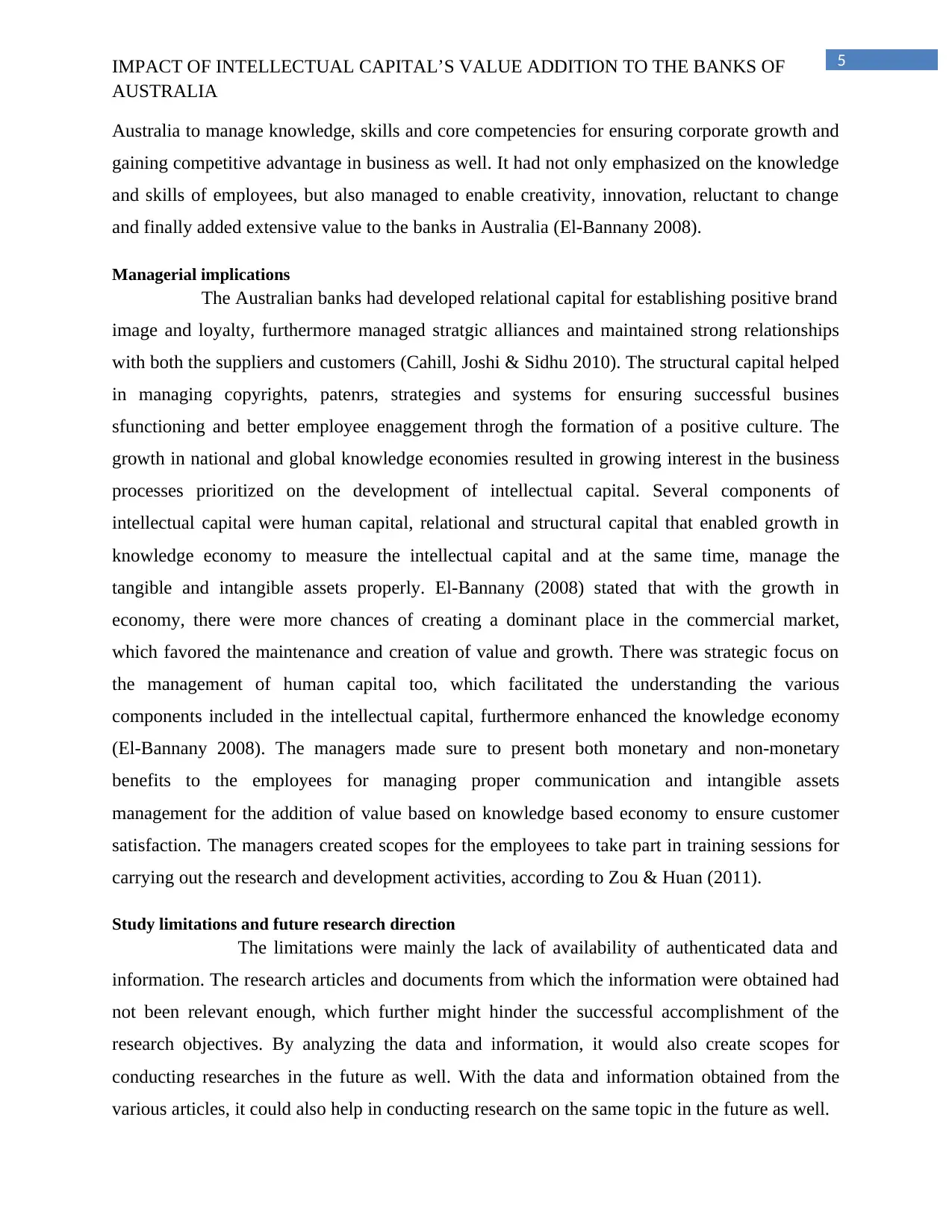
5IMPACT OF INTELLECTUAL CAPITAL’S VALUE ADDITION TO THE BANKS OF
AUSTRALIA
Australia to manage knowledge, skills and core competencies for ensuring corporate growth and
gaining competitive advantage in business as well. It had not only emphasized on the knowledge
and skills of employees, but also managed to enable creativity, innovation, reluctant to change
and finally added extensive value to the banks in Australia (El-Bannany 2008).
Managerial implications
The Australian banks had developed relational capital for establishing positive brand
image and loyalty, furthermore managed stratgic alliances and maintained strong relationships
with both the suppliers and customers (Cahill, Joshi & Sidhu 2010). The structural capital helped
in managing copyrights, patenrs, strategies and systems for ensuring successful busines
sfunctioning and better employee enaggement throgh the formation of a positive culture. The
growth in national and global knowledge economies resulted in growing interest in the business
processes prioritized on the development of intellectual capital. Several components of
intellectual capital were human capital, relational and structural capital that enabled growth in
knowledge economy to measure the intellectual capital and at the same time, manage the
tangible and intangible assets properly. El-Bannany (2008) stated that with the growth in
economy, there were more chances of creating a dominant place in the commercial market,
which favored the maintenance and creation of value and growth. There was strategic focus on
the management of human capital too, which facilitated the understanding the various
components included in the intellectual capital, furthermore enhanced the knowledge economy
(El-Bannany 2008). The managers made sure to present both monetary and non-monetary
benefits to the employees for managing proper communication and intangible assets
management for the addition of value based on knowledge based economy to ensure customer
satisfaction. The managers created scopes for the employees to take part in training sessions for
carrying out the research and development activities, according to Zou & Huan (2011).
Study limitations and future research direction
The limitations were mainly the lack of availability of authenticated data and
information. The research articles and documents from which the information were obtained had
not been relevant enough, which further might hinder the successful accomplishment of the
research objectives. By analyzing the data and information, it would also create scopes for
conducting researches in the future as well. With the data and information obtained from the
various articles, it could also help in conducting research on the same topic in the future as well.
AUSTRALIA
Australia to manage knowledge, skills and core competencies for ensuring corporate growth and
gaining competitive advantage in business as well. It had not only emphasized on the knowledge
and skills of employees, but also managed to enable creativity, innovation, reluctant to change
and finally added extensive value to the banks in Australia (El-Bannany 2008).
Managerial implications
The Australian banks had developed relational capital for establishing positive brand
image and loyalty, furthermore managed stratgic alliances and maintained strong relationships
with both the suppliers and customers (Cahill, Joshi & Sidhu 2010). The structural capital helped
in managing copyrights, patenrs, strategies and systems for ensuring successful busines
sfunctioning and better employee enaggement throgh the formation of a positive culture. The
growth in national and global knowledge economies resulted in growing interest in the business
processes prioritized on the development of intellectual capital. Several components of
intellectual capital were human capital, relational and structural capital that enabled growth in
knowledge economy to measure the intellectual capital and at the same time, manage the
tangible and intangible assets properly. El-Bannany (2008) stated that with the growth in
economy, there were more chances of creating a dominant place in the commercial market,
which favored the maintenance and creation of value and growth. There was strategic focus on
the management of human capital too, which facilitated the understanding the various
components included in the intellectual capital, furthermore enhanced the knowledge economy
(El-Bannany 2008). The managers made sure to present both monetary and non-monetary
benefits to the employees for managing proper communication and intangible assets
management for the addition of value based on knowledge based economy to ensure customer
satisfaction. The managers created scopes for the employees to take part in training sessions for
carrying out the research and development activities, according to Zou & Huan (2011).
Study limitations and future research direction
The limitations were mainly the lack of availability of authenticated data and
information. The research articles and documents from which the information were obtained had
not been relevant enough, which further might hinder the successful accomplishment of the
research objectives. By analyzing the data and information, it would also create scopes for
conducting researches in the future as well. With the data and information obtained from the
various articles, it could also help in conducting research on the same topic in the future as well.

6IMPACT OF INTELLECTUAL CAPITAL’S VALUE ADDITION TO THE BANKS OF
AUSTRALIA
References
banks’ performance in China. African Journal of Business Management. 5(12): 5001-
5009.
Cahill, D, Joshi, M. & Sidhu, J. (2010). Intellectual capital performance in the banking
sector: An assessment of Australian owned banks. Journal of Human Resource Costing
and Accounting. 14(2): 151-170.
El-Bannany, M. (2008). A study of determinants of intellectual capital performance in
banks: The UK case. Journal of Intellectual Capital. 9(3): 487-498.
Pulic, A. (1998). Measuring the Performance of Intellectual Potential in Knowledge
Economy. 2nd McMaster World Congress on Measuring and Managing Intellectual
Capital. McMaster University: Hamilton, Canada.
Zou, X. & Huan, T.C. (2011). A study of the intellectual capital’s impact on listed
AUSTRALIA
References
banks’ performance in China. African Journal of Business Management. 5(12): 5001-
5009.
Cahill, D, Joshi, M. & Sidhu, J. (2010). Intellectual capital performance in the banking
sector: An assessment of Australian owned banks. Journal of Human Resource Costing
and Accounting. 14(2): 151-170.
El-Bannany, M. (2008). A study of determinants of intellectual capital performance in
banks: The UK case. Journal of Intellectual Capital. 9(3): 487-498.
Pulic, A. (1998). Measuring the Performance of Intellectual Potential in Knowledge
Economy. 2nd McMaster World Congress on Measuring and Managing Intellectual
Capital. McMaster University: Hamilton, Canada.
Zou, X. & Huan, T.C. (2011). A study of the intellectual capital’s impact on listed
1 out of 7
![[object Object]](/_next/static/media/star-bottom.7253800d.svg)





